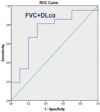Quantitative and semi-quantitative computed tomography analysis of interstitial lung disease associated with systemic sclerosis: A longitudinal evaluation of pulmonary parenchyma and vessels
- PMID: 30861018
- PMCID: PMC6414027
- DOI: 10.1371/journal.pone.0213444
Quantitative and semi-quantitative computed tomography analysis of interstitial lung disease associated with systemic sclerosis: A longitudinal evaluation of pulmonary parenchyma and vessels
Abstract
Objectives: To evaluate interstitial lung disease associated with systemic sclerosis (SSc-ILD) and its changes during treatment by using quantitative analysis (QA) compared to semi-quantitative analysis (semiQA) of chest computed tomography (CT) scans. To assess the prognostic value of QA in predicting functional changes.
Materials and methods: We retrospectively selected 35 consecutive patients with SSc-ILD with complete pulmonary functional evaluation, Doppler-echocardiography, immunological tests, and chest CT scan at both baseline and follow-up after immunosuppressive therapy. CT images were analyzed by two chest radiologists for semiQA and by a computational platform for texture analysis of ILD patterns (CALIPER) for QA. Concordance between semiQA and QA was tested. Traction bronchiectasis severity was scored. Analysis of ROC curves was performed.
Results: Seventy CT scans were analyzed and QA failed in 4/70 scans. Thus, the final population included 31/35 patients (51.3±12.1 years). QA had a weak-to-good concordance with semiQA (ICC reticular:0.275; ICC ground-glass:0.667) and QA correlated better than semiQA (r = -0.3 to -0.74 vs r = -0.3 to -0.4) with functional parameters. Both methods correlated with traction bronchiectases score and pulmonary artery diameter at CT. A pulmonary artery diameter ≥29mm distinguished patients with lower lung volumes and ILD extent greater than 39% (p<0.001). Changes in QA patterns during treatment were not accurate (AUC: 0.50 to 0.70; p>0.05) in predicting disease progression as assessed by functional parameters, whereas variation in total lung volume at QA accurately predicted changes in the composite functional respiratory endpoint with FVC% and DLco% (AUC = 0.74; 95%CI: 0.54 to 0.93; p = 0.03).
Conclusions: Pulmonary QA of CT images can objectively quantify specific patterns of ILD changes during treatment in patients with SSc-ILD. Changes in QA patterns do not correlate with functional changes, but variation in total lung volume at QA accurately predicted changes in the composite functional respiratory endpoint with FVC% and DLco%. Pulmonary artery diameter at CT reflects the interstitial involvement, identifying patients with more severe prognosis.
Conflict of interest statement
MO received consultancies from Imbio, LLC, all remaining authors have declared that no competing interests exist. This does not alter our adherence to PLOS ONE policies on sharing data and materials.
Figures



Similar articles
-
Assessment of interstitial lung disease in systemic sclerosis using the quantitative CT algorithm CALIPER.Clin Rheumatol. 2020 May;39(5):1537-1542. doi: 10.1007/s10067-020-04938-3. Epub 2020 Jan 15. Clin Rheumatol. 2020. PMID: 31940114
-
Quantitative analysis of pulmonary vasculature in systemic sclerosis at spirometry-gated chest CT.Ann Rheum Dis. 2020 Sep;79(9):1210-1217. doi: 10.1136/annrheumdis-2020-217359. Epub 2020 Jun 30. Ann Rheum Dis. 2020. PMID: 32606043
-
Association of Computed Tomography Densitometry with Disease Severity, Functional Decline, and Survival in Systemic Sclerosis-associated Interstitial Lung Disease.Ann Am Thorac Soc. 2020 Jul;17(7):813-820. doi: 10.1513/AnnalsATS.201910-741OC. Ann Am Thorac Soc. 2020. PMID: 32191491
-
Interstitial lung disease in systemic sclerosis.Autoimmun Rev. 2011 Mar;10(5):248-55. doi: 10.1016/j.autrev.2010.09.012. Epub 2010 Sep 21. Autoimmun Rev. 2011. PMID: 20863911 Review.
-
Serum concentration of surfactant protein D in patients with systemic sclerosis: The potential marker of the interstitial lung disease severity.Best Pract Res Clin Rheumatol. 2018 Aug;32(4):541-549. doi: 10.1016/j.berh.2019.01.005. Epub 2019 Feb 14. Best Pract Res Clin Rheumatol. 2018. PMID: 31174823 Review.
Cited by
-
Different chest HRCT scan protocols change the extent of ground glass opacities.BMC Pulm Med. 2022 Nov 21;22(1):430. doi: 10.1186/s12890-022-02212-7. BMC Pulm Med. 2022. PMID: 36404311 Free PMC article.
-
Quantitative chest computed tomography predicts mortality in systemic sclerosis: A longitudinal study.PLoS One. 2024 Sep 27;19(9):e0310892. doi: 10.1371/journal.pone.0310892. eCollection 2024. PLoS One. 2024. PMID: 39331602 Free PMC article.
-
Association of tracheal diameter with respiratory function and fibrosis severity in idiopathic pulmonary fibrosis patients.BMC Pulm Med. 2025 Apr 5;25(1):157. doi: 10.1186/s12890-025-03624-x. BMC Pulm Med. 2025. PMID: 40188355 Free PMC article.
-
A systematic review of the role of quantitative CT in the prognostication and disease monitoring of interstitial lung disease.Eur Respir Rev. 2025 Apr 30;34(176):240194. doi: 10.1183/16000617.0194-2024. Print 2025 Apr. Eur Respir Rev. 2025. PMID: 40306954 Free PMC article.
-
Meaningful Endpoints for Idiopathic Pulmonary Fibrosis (IPF) Clinical Trials: Emphasis on 'Feels, Functions, Survives'. Report of a Collaborative Discussion in a Symposium with Direct Engagement from Representatives of Patients, Investigators, the National Institutes of Health, a Patient Advocacy Organization, and a Regulatory Agency.Am J Respir Crit Care Med. 2024 Mar 15;209(6):647-669. doi: 10.1164/rccm.202312-2213SO. Am J Respir Crit Care Med. 2024. PMID: 38174955 Free PMC article.
References
-
- Steen VD, Owens GR, Fino GJ, Rodnan GP, Medsger TA Jr. Pulmonary involvement in systemic sclerosis (scleroderma). Arthritis Rheum 1985; 28:759–767. - PubMed
-
- Desai SR, Veeraraghavan S, Hansell DM, Nikolakopolou A, Goh NS, Nicholson AG, et al. CT features of lung disease in patients with systemic sclerosis: comparison with idiopathic pulmonary fibrosis and nonspecific interstitial pneumonia. Radiology 2004; 232:560–567. - PubMed
MeSH terms
Substances
LinkOut - more resources
Full Text Sources
Medical

